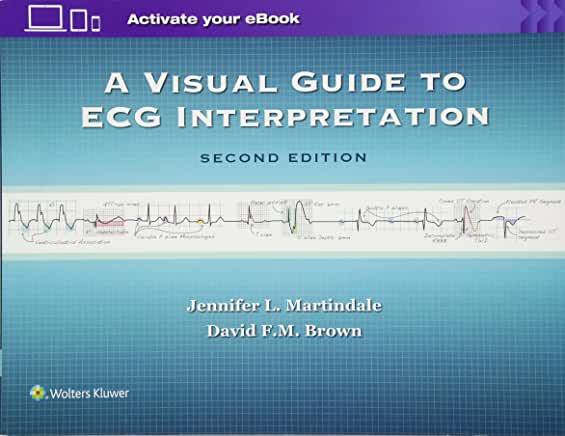The current edition of A Visual Guide to ECG Interpretation (2017), much like the previous one (which I reviewed elsewhere), is a marked-up atlas of important, must-be-able-to-interpret-correctly electrocardiograms. Almost every important ECG that you can think of can be found here: coronary ischemia and occlusion, hyperkalemia, Brugada pattern, Wolff-Parkinson-White pattern, Wellens sign, arrhythmogenic right ventricular cardiomyopathy, and many more.
These important electrocardiographic findings are shown both as unkowns and as fully marked-up versions with highlights, arrows, and text. That way, the learner can first look at the unknown, guess the interpretation, and then look at the marked-up version for confirmation and explanation. There are sometimes several variations of important ECG patterns, which helps improve the learner’s ability to identify and diagnose important ECG abnormalities. Also, there is an excellent introductory essay with illustrations and algorithms at the beginning of each chapter: the authors tell you what they are going to show you, then they show it to you, and then they explain to you what they just showed you.

(The previous edition of this book was unfortunately titled Rapid Interpretation of ECGs in Emergency Medicine: A Visual Guide (2012). When I reviewed it in 2013, I wrote:
The titling of the book as an emergency medicine work is a bit unfortunate because, as the authors correctly point out in the preface, the intended audience “is not only emergency physicians, but also physicians from other specialties; residents in emergency medicine, internal medicine, and family practice; physician assistants; nurse practitioners; and advanced medical students who want to become more competent in ECG interpretation.”
The title, as it stands, artificially limits the market potential of this book in a very substantial way. Further, one shouldn’t have to wait for the third line of the title to learn that we are dealing with “a visual guide.” The book is first and foremost a visual guide to ECGs. Therefore, the next edition should probably be titled more simply: A Visual Guide to ECG Interpretation.
Book Review: Rapid Interpretation of ECGs in Emergency Medicine (emphasis added)
Perhaps as a consequence of this suggestion—or by sheer coincidence—the current Edition is in fact titled, you guessed it, A Visual Guide to ECG Interpretation!).
Unfortunately, I already tossed out the previous edition of this book so I’m not readily able to make side-by-side comparison between the two editions. That said, the new edition comes with free online access to the e-book and is approximately 50 pages longer. I’d go with the newer version if you can afford it. (You can rent it for around $20 on Amazon).
I recommend A Visual Guide to ECG Interpretation (2017) very highly to residents and to advanced medical students who have an interest in internal medicine, emergency medicine, or cardiology. It is the best electrocardiography book for intermediate to advanced learners.


Leave a Reply